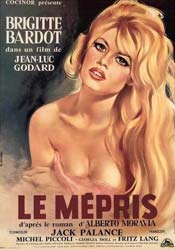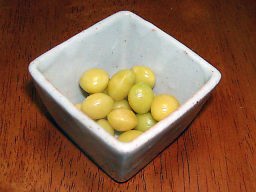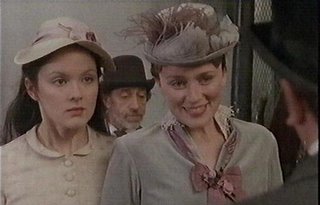
Jeff and I just got back from our three-day trip to
Tybee Island yesterday. What a short, strange trip it's been (I swear it seemed to last all of twenty minutes).
On Thursday, I was all business, getting ready to go. I dropped Jeff off at work early in the morning, came home and packed up all our clothes and
all the food I'd been preparing that week. It took me a long time to get the car loaded up (we live on the tenth floor). The cooler was HEAVY, too. I made some green tea for the thermos and packed all the booze in a box. I was finished at about one and then I just had to wait impatiently until Jeff got off at two.
I picked up Jeff and we left straight from his office, heading down Interstate 75. The drive to Savannah is only 4 hours, and Tybee is just another 30 minutes or so from there, but man, I hate a car trip.
I was all tense and jittery by the time we got everything into our hotel room. Don't ask me why, but checking into a hotel is a locus of stress for me. I always neurose that they'll lose my reservation or say the price of the room has gone up or that they'll be all, "We don't allow the gays here," or something.
I was hoping we'd make it to Tybee before sunset, but unfortunately it was already dark. Anyway, Jeff offered to make me a gin and tonic, and I ordered a double. It was really cold outside, so we couldn't go out and I was disappointed by the room: we were facing the ocean and had a view of the beach and could even see the water, but we were on the first floor and I had been hoping that we'd be higher up so we'd really have a panorama.
Like I said, I was a totally tense crankazoid after the car trip and I was just trying to do that "I should be satisfied with what I have," yogi thing about the disappointing room, slugging down my not-quite-right (shh. don't tell Jeff) gin and tonic (I'm picky). I turned on the TV to see if I could find a movie, but the only thing I could find was Bridget Jones' Diary, and that seemed just too self-torturing to do to myself on top of everything else, so I switched it off.
The  next morning, Jeff and I woke up to the most mind-blowing sunrise outside our window, a performance that was repeated every day we were there. Just gorgeous, almost impossible to describe, so I won't try, but know that it was sunrise double-plus-good.
next morning, Jeff and I woke up to the most mind-blowing sunrise outside our window, a performance that was repeated every day we were there. Just gorgeous, almost impossible to describe, so I won't try, but know that it was sunrise double-plus-good.
It was a strange disjunct on Friday because it was so damn cold. From the window, we saw palm trees, sea gulls, white sand, sea oats, the verging sea, bright blue skies, but then stepped outside and it felt like the Arctic.
We bundled up and went down to the beach after breakfast. It was beautiful and empty, but so cold and windy we couldn't even stay long. We just hung out in the room until the afternoon when we REALLY bundled up in layer after layer with hats, gloves and scarves and went on a walk at the beach.
It was still cold, but we managed to make it down to the south end of Tybee where the beach meets the back river. There was only one other person on the beach--even at the pier--which in the summertime, as you may know, is so crowded with people it can be hard to walk through at high tide. It's typically noisy and festive like Coney Island around the pier, so it was very surreal and evocative to be there when it was totally empty, walking to the end of the pier where there were just some addled-looking sea fowl with ruffled feathers. Adding to the strangeness of the scene was the fact that the only other person in sight was a lone woman--I kid you not--in a hooded, red cloak walking slowly along the beach.
end of Tybee where the beach meets the back river. There was only one other person on the beach--even at the pier--which in the summertime, as you may know, is so crowded with people it can be hard to walk through at high tide. It's typically noisy and festive like Coney Island around the pier, so it was very surreal and evocative to be there when it was totally empty, walking to the end of the pier where there were just some addled-looking sea fowl with ruffled feathers. Adding to the strangeness of the scene was the fact that the only other person in sight was a lone woman--I kid you not--in a hooded, red cloak walking slowly along the beach.
I found a sand dollar.
Our  hotel was the Ocean Plaza which the locals--I assume--refer to as "the eyesore." It's not so horrible, I suppose, it's just a little out of proportion with the rest of what's on Tybee. The deal we got was great though: just $40 a night for a room that faced the ocean and was a few steps from the beach.
hotel was the Ocean Plaza which the locals--I assume--refer to as "the eyesore." It's not so horrible, I suppose, it's just a little out of proportion with the rest of what's on Tybee. The deal we got was great though: just $40 a night for a room that faced the ocean and was a few steps from the beach.
We brought our own microwave--or rather I borrowed it from my parents because Jeff and I don't have one--so we could heat up food in our rooms. We had a cooler, too, which we kept on filling with ice from the machine in the hallway.
Our room came with a total bonus. On Friday, Jeff found a Fantastic Four Invisible Woman doll that some kid had left by the window. We didn't even have to shop for souveniers.
Invisible Woman doll that some kid had left by the window. We didn't even have to shop for souveniers.
Late Friday afternoon, we headed in to Savannah. It was a little before five so when we parked, I had to put one quarter into the meter to cover that little bit of time until the weekend started.
(It was wierd: when we stepped out of our car, we'd parked in front of a gorgeous old Savannah home. The door to the bottom floor was open and we could see inside from the street this long dining room table all set for a fancy dinner party. There was no one in there, but the stereo was blasting--and I mean blasting--this really horrible music: it sounded like Michael Bolton covering a Chicago song backed up by Yanni and Kenny G. It was so loud I could barely talk to Jeff about how many quarters to put in the meter.)
We walked to Vintage Vinyl on State Street and dug through the record bins. They had a lot of great stuff, but they were more than a little over-priced. I  saw things like Beatles albums I had bought at garage sales for maybe a buck with thirty dollar pricetags.
saw things like Beatles albums I had bought at garage sales for maybe a buck with thirty dollar pricetags.
In the end I managed to find a few much more reasonably-priced discs: I got Dinah Washington Drinking Again, Ike and Tina Turner Live at Carnegie Hall and Kay Thompson Party: Let's Talk About Russia in which the eccentric 50s personality, author of the Eloise children's books (think Diana Vreeland meets Liza Minnelli) describes her trip to Moscow at a cocktail party, complete with clinking drink glasses, ringing telephones and background (and sometimes foreground... Speak up Kay!) balalaika music. (Who thinks of these things?)
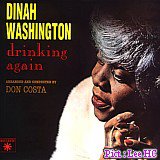
The guy at the cash register pointed out that the Drinking Again title of the Dinah Washington album was totally ironic, considering her death was drinking related. Thanks, cash register guy, I didn't know that. Now I'll think of that and get depressed every time I put the album on.
Afterwards, we headed over to our favorite Savannah cafe The Sentient Bean, where I ordered a hot chocolate--it was awesome--and Jeff ordered a coffee. Strangely, the girl behind the counter kept trying to give Jeff too much money. He handed her a five to pay for the drinks and she gave him change for a twenty, and when he pointed this out (the difference between me and Jeff illustrated) she gave him too much change again, about a dollar extra, which Jeff left as a tip.
Next we hurried over to a little black box theater at Savannah College of Art and Design where the Performance and Drama students were putting on a little production. Well-known performance artist Tim Miller had been leading a two-week workshop at SCAD and this was the culmination, the students did a little show where they each did a monologue or performance piece about some personal experience or piece of personal history.
The show was excellent, and it was surprising how many talented young people there were among the fifteen or so drama students who had participated in the workshop. I couldn't believe how revealing the students' pieces were. They did what I could never do: stood in front of a crowd of strangers and talked about the most embarassing private stuff: suicide attempts or how they didn't feel sad at a family member's funeral or childhood fatness or humiliating break-ups and the like. They managed to make it all funny, original, moving and entertaining, and, on top of it all, the show was totally free. It was a lot better than plenty of professional shows I've paid to see in Atlanta.
I didn't like the fact that the show opened with a bit of audience participation--my least favorite form of theater. We had to wait outside the theater for a long time until one of the student actors led us inside and introduced themsleves and showed us around the theater and up to a little drawing they'd done of themselves. I was tired of standing around and just wanted to sit down and watch a show, but I did my best to be polite and talkative to our guide, Jessica, who was very nice and showed us her little self-portrait and told us about how she broke her arm twice.
It was too cold to walk around Savannah after the show, and although we'd even brought cocktail fixings so we could tailgate and do just that, we decided to head back to the hotel.
The next day it was thankfully warmer . We bundled up a bit and went for a long walk on the beach. From the south end where our hotel was, we walked all the way to the north end as far as we could go, maybe four miles or so.
. We bundled up a bit and went for a long walk on the beach. From the south end where our hotel was, we walked all the way to the north end as far as we could go, maybe four miles or so.
I found another, even better, sand dollar on the north end of Tybee, where the Savannah River meets the sea, where Sandra Bullock has a home. It was a wonderful walk that took all morning, probably eight miles total. It was totally gorgeous, the reason we came really.
We were pretty tired when we got back, so we just had some lunch and chilled, then at sunset took a walk to find the back pier. We had our daily gin and tonic first then made some cocktails in to-go cups to take with us. I'd never been to the back pier part of the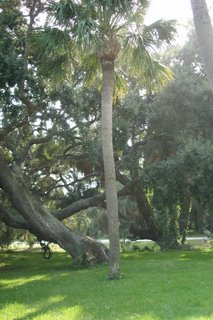 island before, but had always been curious. It took us a while to find it, but it was really cool, this public concrete deck that stuck out into the back river into the sawgrass. The setting sun was so gorgeous we just sat down and watched these kayakers paddling around out on the tidal river. It may have been the light--or maybe the cocktails--but I kept seeing these really interesting, psychadelic, eye-popping, vivid, repeating patterns in the ripples on the water.
island before, but had always been curious. It took us a while to find it, but it was really cool, this public concrete deck that stuck out into the back river into the sawgrass. The setting sun was so gorgeous we just sat down and watched these kayakers paddling around out on the tidal river. It may have been the light--or maybe the cocktails--but I kept seeing these really interesting, psychadelic, eye-popping, vivid, repeating patterns in the ripples on the water.
When we got back to the hotel room, it was still warm (or rather slightly warmer than the day before). I knew it was now or never. I put on my flip-flops and went down to the water (with another cocktail) to stick my feet in. Incredibly, there were people swimming--I think they must have been high-school kids on a dare. The water was freezing, but felt totally refreshing and cleansing on my feet.
All in all, this short vacation seemed to fly by. I'm sure you probably know the feeling: blink and you miss it?
Before we  knew it, it was Sunday morning and time to check out of the hotel. We stopped at a bakery called B. Matthews in Savannah on the way out to get some mocha and a banana nut muffin and spinach-feta croissant, all of which were delicious and the staff was super cute and way flirty--or at least the cute, flirty one was--which was a totally nice way to leave the city and end our small vacation.
knew it, it was Sunday morning and time to check out of the hotel. We stopped at a bakery called B. Matthews in Savannah on the way out to get some mocha and a banana nut muffin and spinach-feta croissant, all of which were delicious and the staff was super cute and way flirty--or at least the cute, flirty one was--which was a totally nice way to leave the city and end our small vacation.
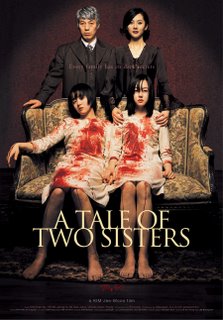 Have you ever had the strange feeling that there really is something in that tiny space between the stove and the floor? And maybe it's, like, watching you?
Have you ever had the strange feeling that there really is something in that tiny space between the stove and the floor? And maybe it's, like, watching you?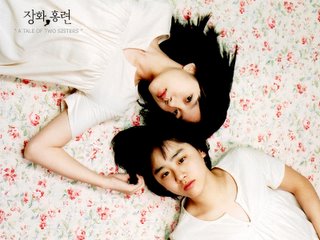 lls the tale of two sisters: they've recently returned from a mental institution to their new, isolated home (a creepy, old house to end all creepy old houses), presided over by their evil step-mother.
lls the tale of two sisters: they've recently returned from a mental institution to their new, isolated home (a creepy, old house to end all creepy old houses), presided over by their evil step-mother.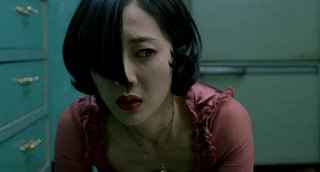 from a slow accumulation of images and events. The first half of the film is straightforward enough, but as in Mulholland Drive, the film contains a sort of "split" in the middle after which the tale starts to become more fragmented.
from a slow accumulation of images and events. The first half of the film is straightforward enough, but as in Mulholland Drive, the film contains a sort of "split" in the middle after which the tale starts to become more fragmented.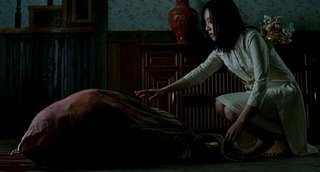 explanation for what you see: rather, just let the film's terrifying images and creepy atmosphere take you where they want to. As in Mulholland Drive, you may be at a loss to explain what you've just seen, but you know it's taken hold of you. A Tale of Two Sisters is a stylish psychological horror film that keeps its biggest secrets hidden, but still somehow knows just how to get under your skin.
explanation for what you see: rather, just let the film's terrifying images and creepy atmosphere take you where they want to. As in Mulholland Drive, you may be at a loss to explain what you've just seen, but you know it's taken hold of you. A Tale of Two Sisters is a stylish psychological horror film that keeps its biggest secrets hidden, but still somehow knows just how to get under your skin.



